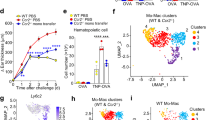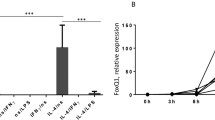Abstract
Objective
Histamine is an important mediator of biological functions and present in high amounts in inflammatory skin lesions which are characterised by a marked infiltration of myeloid derived cell populations. The aim of the study was to investigate the expression and function of histamine receptors, with a focus on the histamine H4 receptor (H4R) in detail during the differentiation process from monocytes to macrophages and on fully differentiated M1 macrophages.
Methods
Quantitative PCR, ELISA technique, and flow cytometry were applied to analyze expression levels of histamine receptors, of CXCL10, CCL4, CCL3, or IL-23 and of the macrophage differentiation marker CD68, respectively.
Results
We demonstrated that monocytes and fully differentiated M1 macrophages express H1R-, H2R-, and H4R mRNA which were differentially regulated during the differentiation process and in IFN-Ƴ and LPS classically activated M1 macrophages. The H3R mRNA was not expressed. During in vitro differentiation from monocytes to macrophages, the H4R agonist ST-1006 modified the M1 phenotype by up-regulating the macrophage differentiation marker CD68, by down-regulating the production of CXCL10, and by changing the morphology. In fully differentiated M1 macrophages, histamine or ST-1006 decreased the IFN-Ƴ- and LPS-induced CCL4 mRNA expression and protein production, whereas CCL3 or IL-23 production was not regulated via H4R.
Conclusions
We describe novel immunomodulatory functions of the H4R during the differentiation process of human monocyte-derived macrophages and in fully differentiated M1 macrophages. The down-regulation of Th1-related chemokines during the differentiation process or in classically activated macrophages via H4R may contribute to decreased migration of immune cells to the site of inflammation. This may have implications for the treatment of allergic diseases with H4R ligands regulating the dysbalance of Th2/Th1 polarizations in these disorders.





Similar content being viewed by others
Abbreviations
- AD:
-
Atopic dermatitis
- DCs:
-
Dendritic cells
- H4R:
-
Histamine H4 receptor
References
Hume DA, Summers KM, Rehli M. Transcriptional regulation and macrophage differentiation. Microbiol Spectr. 2016;MCHD-0024-2015.
Mosser DM. The many faces of macrophage activation. J Leukoc Biol. 2003;73:209–12.
Stout RD, Jiang C, Matta B, Tietzel I, Watkins SK, Suttles J. Macrophages sequentially change their functional phenotype in response to changes in microenvironmental influences. J Immunol. 2005;175:342–9.
Martinez FO, Gordon S, Locati M, Mantovani A. Transcriptional profiling of the human monocyte-to-macrophage differentiation and polarization: new molecules and patterns of gene expression. J Immunol. 2006;177(10):7303–11.
Anthony RM, Urban JF Jr, Alem F, Hamed HA, Rozo CT, Boucher JL, et al. Memory T(H)2 cells induce alternatively activated macrophages to mediate protection against nematode parasites. Nat Med. 2006;12:955–60.
Biswas SK, Mantovani A. Macrophage plasticity and interaction with lymphocyte subsets: cancer as a paradigm. Nat Immunol. 2010;11:889–96.
Ginhoux F, Schultze JL, Murray PJ, Ochando J, Biswas SK. New insights into the multidimensional concept of macrophage ontogeny, activation and function. Nat Immunol. 2015;17:34–40.
Kasraie S, Werfel T. Role of macrophages in the pathogenesis of atopic dermatitis. Mediators Inflamm. 2013;2013:942375.
Mantovani A, Sica A, Sozzani S, Allavena P, Vecchi A, Locati M. The chemokine system in diverse forms of macrophage activation and polarization. Trends Immunol. 2004;25:677–86.
Shaik-Dasthagirisaheb YB, Conti P. Letter to editor: chemokine network involved in inflammatory skin diseases. Ann Clin Lab Sci. 2015;45:452–7.
Ruzicka T, Glück S. Cutaneous histamine levels and histamine releasability from the skin in atopic dermatitis and hyper-IgE-syndrome. Arch Dermatol Res. 1983;275:41–4.
Krogstad AL, Lonnroth P, Larson G, Wallin BG. Increased interstitial histamine concentration in the psoriatic plaque. J Invest Dermatol. 1997;109:632–5.
Gschwandtner M, Bunk H, Kother B, Thurmond RL, Kietzmann M, Werfel T, et al. Histamine down-regulates IL-27 production in antigen-presenting cells. J Leukoc Biol. 2012;92:21–9.
Glatzer F, Mommert S, Kother B, Gschwandtner M, Stark H, Werfel T, et al. Histamine downregulates the Th1-associated chemokine IP-10 in monocytes and myeloid dendritic cells. Int Arch Allergy Immunol. 2014;163:11–9.
Gutzmer R, Diestel C, Mommert S, Kother B, Stark H, Wittmann M, et al. Histamine H4 receptor stimulation suppresses IL-12p70 production and mediates chemotaxis in human monocyte-derived dendritic cells. J Immunol. 2005;174:5224–32.
Gschwandtner M, Mommert S, Kother B, Werfel T, Gutzmer R. The histamine H4 receptor is highly expressed on plasmacytoid dendritic cells in psoriasis and histamine regulates their cytokine production and migration. J Invest Dermatol. 2011;131:1668–76.
Mommert S, Dittrich-Breiholz O, Stark H, Gutzmer R, Werfel T. The histamine H4 receptor regulates chemokine production in human natural killer cells. Int Arch Allergy Immunol. 2015;166:225–30.
Gutzmer R, Mommert S, Gschwandtner M, Zwingmann K, Stark H, Werfel T. The histamine H4 receptor is functionally expressed on T(H)2 cells. J Allergy Clin Immunol. 2009;123:619–25.
Mommert S, Gschwandtner M, Koether B, Gutzmer R, Werfel T. Human memory Th17 cells express a functional histamine H4 receptor. Am J Pathol. 2012;180:177–85.
Sander K, Kottke T, Tanrikulu Y, Proschak E, Weizel L, Schneider EH, et al. 2,4-diaminopyrimidines as histamine H4 receptor ligands–scaffold optimization and pharmacological characterization. Bioorg Med Chem. 2009;17:7186–96.
Gschwandtner M, Koether B, Werfel T, Stark H, Gutzmer R. Profiling of histamine H4 receptor agonists in native human monocytes. Br J Pharmacol. 2013;170:136–43.
Weinmann O, Gutzmer R, Zwirner J, Wittmann M, Langer K, Lisewski M, et al. Up-regulation of C5a receptor expression and function on human monocyte derived dendritic cells by prostaglandin E2. Immunology. 2003;110:458–65.
McWhorter FY, Wang T, Nguyen P, Chung T, Liu WF. Modulation of macrophage phenotype by cell shape. Proc Natl Acad Sci USA. 2013;110:17253–8.
Lang R, Patel D, Morris JJ, Rutschman RL, Murray PJ. Shaping gene expression in activated and resting primary macrophages by IL-10. J Immunol. 2002;169:2253–63.
Capelo R, Lehmann C, Ahmad K, Snodgrass R, Diehl O, Ringleb J, et al. Cellular analysis of the histamine H4 receptor in human myeloid cells. Biochem Pharmacol. 2016;103:74–84.
Werner K, Neumann D, Buschauer A, Seifert R. No evidence for histamine H4 receptor in human monocytes. J Pharmacol Exp Ther. 2014;351:519–26.
Triggiani M, Petraroli A, Loffredo S, Frattini A, Granata F, Morabito P, et al. Differentiation of monocytes into macrophages induces the upregulation of histamine H1 receptor. J Allergy Clin Immunol. 2007;119:472–81.
Gschwandtner M, Schakel K, Werfel T, Gutzmer R. Histamine. H(4) receptor activation on human slan-dendritic cells down-regulates their pro-inflammatory capacity. Immunology. 2011;132:49–56.
Holness CL, Simmons DL. Molecular cloning of CD68, a human macrophage marker related to lysosomal glycoproteins. Blood. 1993;81:1607–13.
O’Reilly D, Greaves DR. Cell-type-specific expression of the human CD68 gene is associated with changes in pol II phosphorylation and short-range intrachromosomal gene looping. Genomics. 2007;90:407–15.
Gottfried E, Kunz-Schughart LA, Weber A, Rehli M, Peuker A, Muller A, et al. Expression of CD68 in non-myeloid cell types. Scand J Immunol. 2008;67:453–63.
Rey-Giraud F, Hafner M, Ries CH. In vitro generation of monocyte-derived macrophages under serum-free conditions improves their tumor promoting functions. PLoS One. 2012;7:e42656.
Czerner CP, Klos A, Seifert R, Neumann D. Histamine induces chemotaxis and phagocytosis in murine bone marrow-derived macrophages and RAW 264.7 macrophage-like cells via histamine H4-receptor. Inflamm Res. 2014;63:239–47.
Gros E, Bussmann C, Bieber T, Förster I, Novak N. Expression of chemokines and chemokine receptors in lesional and nonlesional upper skin of patients withatopic dermatitis. J Allergy Clin Immunol. 2009;124:753–60.
Kutukculer N, Azarsiz E, Aksu G, Karaca NE. CD4 + CD25 + Foxp3 + T regulatory cells, Th1 (CCR5, IL-2, IFN-γ) and Th2 (CCR4, IL-4, Il-13) type chemokine receptors and intracellular cytokines in children with common variableimmunodeficiency. Int J Immunopathol Pharmacol. 2016;29:241–51.
Werfel T, Allam JP, Biedermann T, Eyerich K, Gilles S, Guttman-Yassky E, et al. Cellular and molecular immunologic mechanisms in patients with atopic dermatitis. J Allergy Clin Immunol. 2016;138:336–49.
Kollmeier A, Francke K, Chen B, Dunford PJ, Greenspan AJ, Xia Y, et al. The histamine H(4) receptor antagonist, JNJ 39758979, is effective in reducing histamine-induced pruritus in a randomized clinical study in healthy subjects. J Pharmacol Exp Ther. 2014;350:181–7.
Werfel T, Lynch V, Asher A, Tsianakas A, Gupta B, Sarmiento R, et al. Allergy. 2016;71(Suppl.102):95.
Acknowledgements
The authors would like to thank Brigitta Koether and Kira Herwig for excellent technical assistance.
Funding
This study was supported by Grants from the Deutsche Forschungsgemeinschaft DFG: Gu434/6-1. Funding for this research was provided by Janssen Research & Development, LLC.
Author information
Authors and Affiliations
Contributions
SM is the primary author and analyzed the histamine receptor expression on human macrophages, conducted data collection, analysis, interpretation of the data and writing the first draft of the manuscript. LR performed most of the experiments, generating and stimulating the macrophages and performing ELISA and qPCR. HS provided the H4R-agonist ST-1006 and made contributions to the conception, design and interpretation of the data. RG and TW made significant and substantial contributions to the conception, design and interpretation of the data. All authors reviewed, revised, and approved the manuscript for publication.
Corresponding author
Ethics declarations
Conflict of interest
The authors have no conflict of interest to declare.
Additional information
Responsible Editor: Bernhard Gibbs.
Electronic supplementary material
Below is the link to the electronic supplementary material.


Rights and permissions
About this article
Cite this article
Mommert, S., Ratz, L., Stark, H. et al. The histamine H4 receptor modulates the differentiation process of human monocyte-derived M1 macrophages and the release of CCL4/MIP-1β from fully differentiated M1 macrophages. Inflamm. Res. 67, 503–513 (2018). https://doi.org/10.1007/s00011-018-1140-0
Received:
Revised:
Accepted:
Published:
Issue Date:
DOI: https://doi.org/10.1007/s00011-018-1140-0




